White grape varieties: an overview of the best varieties, their characteristics and photos
Now on sale there is a huge number of grape varieties with white berries, so choosing a specific one is very, very difficult.
So that you can decide on the best choice and choose the variety that suits you, below you will be offered an overview of the best and most popular white grape varieties, most of which have long been loved by many winegrowers, while others are just beginning to actively attract the attention of novice summer residents.

Content
- 1 The best white varieties of table (dessert) grapes: top 15 most popular varieties (alphabetically)
- 1.1 Augustine (Pleven Stable, Phenomenon)
- 1.2 Aisar
- 1.3 Aleshenkin (Alyosha)
- 1.4 Arcadia
- 1.5 Bazhena
- 1.6 Bulgaria resilient (Queen of Paris)
- 1.7 Delight White (Delight)
- 1.8 Kesha White (Delight Superior)
- 1.9 Lily of the valley
- 1.10 Laura (Flora)
- 1.11 Monarch (Chrysolite)
- 1.12 Rusbol (Kishmish Mirage)
- 1.13 Super Extra (Citrine)
- 1.14 Talisman (Kesha-1)
- 1.15 Timur
- 2 The best white wine (technical) grapes
The best white varieties of table (dessert) grapes: top 15 most popular varieties (alphabetically)
When they say "white grapes", it is worth understanding that the shade of the berries can vary from light green to amber yellow. Some white varieties also have a certain amber or brown crimson (blush) that they acquire on the sunny side.
Augustine (Pleven Stable, Phenomenon)
Obtained on the basis of crossing Vilan Blanc and Pleven varieties. Bulgarian selection.
The variety is vigorous, therefore suitable for growing on arches.
Forms weighty clusters in the shape of a cone, weighing 400-500 g (maximum up to 750-800 g).
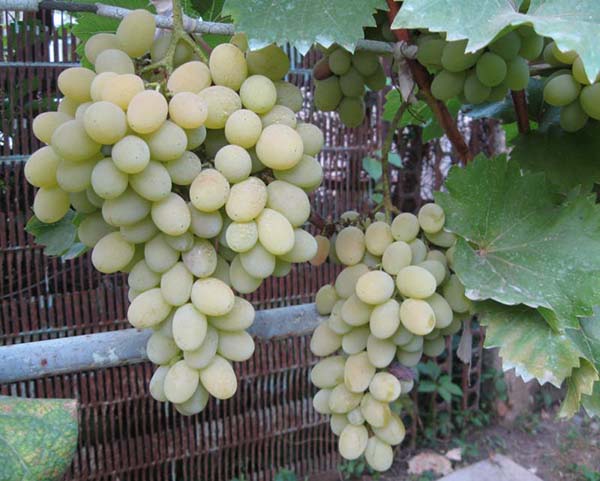
Has a green-yellow fruit color, slightly translucent in the sun. Augustine has a harmonious taste with an unobtrusive light aroma of nutmeg. Fruits are oval-elongated, about 27 mm long and 18 mm wide, weighing 4-7 g. The crispy pulp has a dense (fleshy) consistency, the rind is dense, thin.
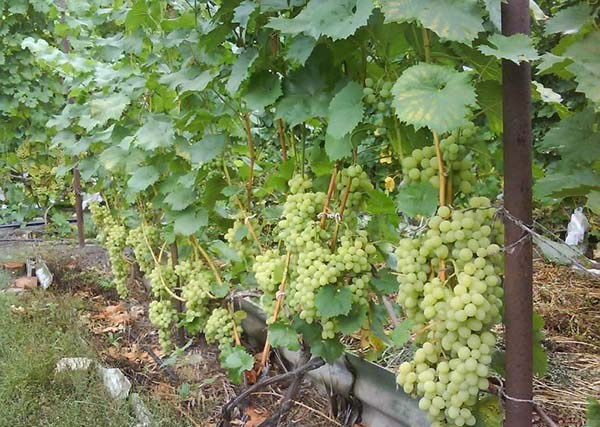
Characteristics of the Augustine variety:
- ripening period - 115-125 days (early);
- yield - 120-140 c / ha:
- sugar content - 17-19 g / l;
- acidity - 6-7 g / l;
- preservation on the crop bush - 2-3 weeks;
- the number of clusters on a fruitful shoot - 1.2-1.6;
- the number of fruitful shoots - 75-85%;
- eye load - 35-50;
- pruning vines is necessary for 8-12 eyes;
- frost resistance up to -22 ..- 24 degrees;
By the way! Augustine is great for creating a gazebo.
Advantages:
- High tasting score (8.2 points).
- The flowers are bisexual, so pollination is good, even under unfavorable conditions.
- Stable high yield.
- Relative unpretentious care.
- High transportability and marketability.
- High resistance to fungal diseases (2-2.5 points).
Disadvantages:
- Berries crack when the soil is too moist.
- It is susceptible to defeat by a grapevine, wasps.
- Often affected by gray rot.
Aisar
Obtained by crossing the Talisman and Richelieu varieties, breeding VNIIViV them. Ya.I. Potapenko.
Bushes above average vigor, vigorous one might say.
The clusters are large, conical, of medium density, the average weight of a cluster is about 600 g.
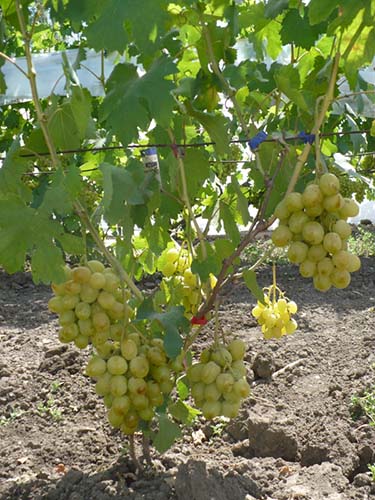
The berries are white, oval in shape (from round to almost cylindrical), the average weight is 11-16 g. The pulp is firm, juicy and fleshy, the taste is very pleasant (sweet) harmonious.
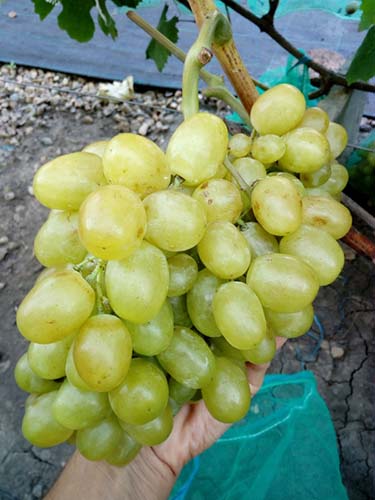
The taste is very similar to the Super Extra variety.
Characteristics of the Aisar variety:
- ripening period - 105-115 (very early);
- the percentage of fruitful shoots - 75-85%;
- fruiting coefficient - 1.4-1.6;
- sugar content - 17.9-23.2 g / 100 cm3;
- acidity - 4-5 g / dm3;
- frost resistance up to -23 degrees.
Advantages:
- High tasting score (8.6 points).
- The flower is bisexual.
- Relative resistance to mildew (3.5 points).
- Excellent transportability and marketability.
- Stores well, even the stalk does not dry out.
If the crop is underloaded, it can yield crops on stepchildren.
Disadvantages:
- Mandatory rationing of the yield is required (on each shoot, 2-3 inflorescences).
- Unstable to powdery mildew.
Aleshenkin (Alyosha)
The variety was obtained by crossing Madeleine Angevin and a mixture of oriental pollen. Volgograd selection.
Medium and vigorous bushes.
Forms large brushes of a loose structure with a conical shape, with an average weight of 350-500 g (maximum up to 2 kg).
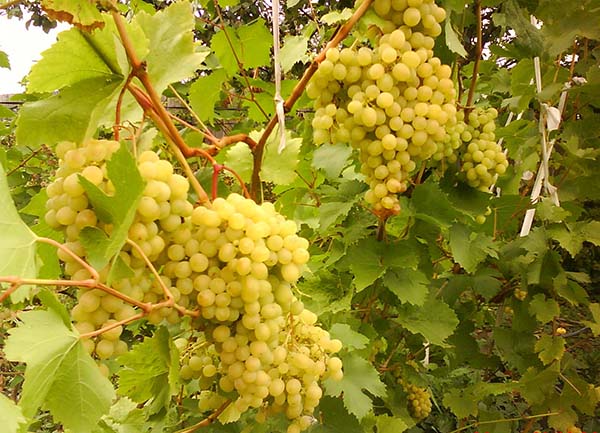
Has an amber hue with a white coating over the skin. Sufficiently small oval fruits, their weight reaches 3-5 g. The skin is thick. The pulp is crispy and juicy, with a pleasant sweet taste.
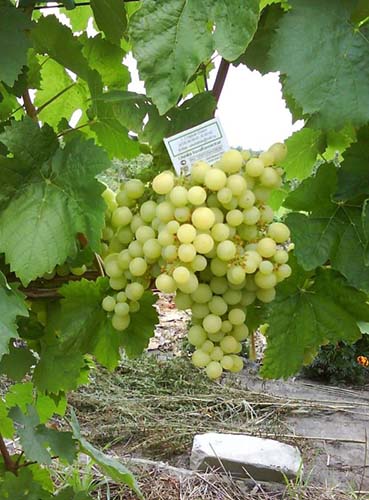
The main characteristics of the Aleshenkin variety:
- ripening period - 100-115 days (very early or very early);
- yield - 8-10 kg per bush.
- acidity - 3-6 g / l;
- sugar accumulation - up to 17-20%;
- eye load - 30-40;
- recommended pruning - for 8-10 eyes (but you can also for a short one - 5-6 eyes);
- frost resistance up to 22 ..- 26 degrees.
Benefits:
- Very high tasting score (8.8 points).
- Consistently high yield.
- Amicable ripening of berries.
- Flowers are bisexual.
- High percentage of rooting cuttings.
Disadvantages:
- Susceptible to fungal diseases.
- Prone to peas.
- Ripening of the vine is satisfactory.
- It is prone to overload, therefore, it requires mandatory rationing (1 brush per 1 shoot).
Arcadia
The variety was bred by crossing the Cardinal, which is responsible for the taste of the prototype, and Moldova, which has resistance genes. Selection IV&V them. V.E. Tairova (Ukraine).
By the way! Arcadia is also sometimes called Nastya.
Arcadia is distinguished by large dense clusters, with an average weight of 500-700 g (maximum - 2-2.5 kg). Their shape is cylindrical-conical, with blades.
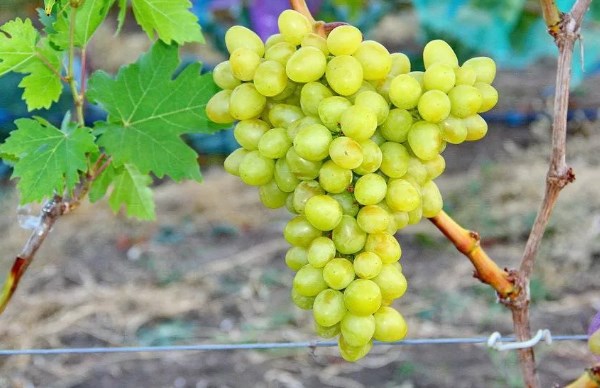
Arcadia berries are characterized by an unobtrusive, simple but pleasant taste, which, when ripe, acquires a slight aroma of nutmeg. The color is uniform white, the size reaches 23 by 28 mm (egg-shaped), the weight is 7-10 g (maximum up to 15 g), depending on the care and agricultural technology (load of the bush). The pulp is dense with a juicy texture, the skin is strong, which makes it possible to transport with a minimum percentage of damage.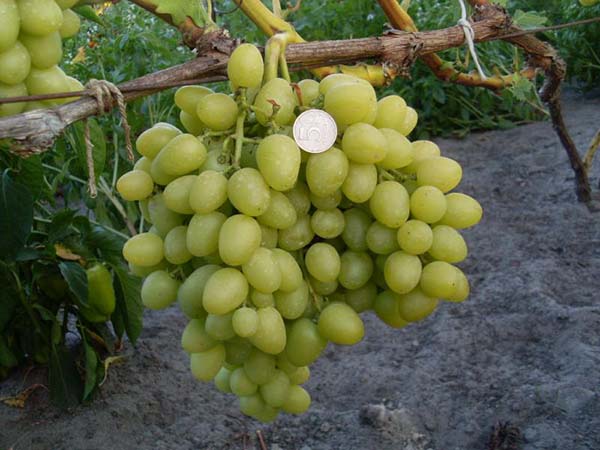
Characteristics of the Arcadia variety:
- ripening period - 115-125 days (early);
- sugar accumulation (sugar content) - 15-16%;
- acid level (acidity) - 4-6 g / l;
- fertility coefficient (the number of clusters on a fruitful shoot) - 1.1-1.6;
- the ratio of fruiting shoots - 60-75%;
- yield - from 20 to 50 kg per bush;
- the load of the eyes on the bush during pruning is 30-50;
- pruning is recommended - for 8-12 eyes;
- frost resistance up to -21 ..- 23;
Note! Arcadia is distinguished by medium or fast growth of shoots and amicable ripening of fruits, which makes it possible to get the first full harvest already in the 3rd year of cultivation.
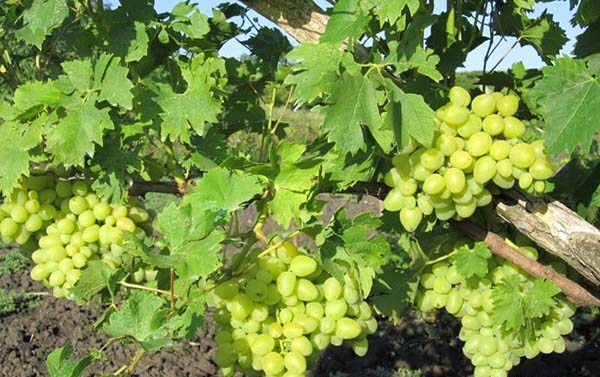
Advantages:
- Excellent tasting performance (8 points).
- Not bad resistance to mildew (3-3.5 points).
- Quite good resistance to gray mold (2.5-3.5 points).
- Wasp is hardly damaged.
- No peas.
- High percentage of rooting cuttings.
- Compatible with many rootstocks.
- High transportability and marketability.
Minuses:
- Cracking during waterlogging of the soil.
- When overloaded with brushes, the ripening of the shoots worsens.
- Susceptible to powdery mildew.
Bazhena
A hybrid form of grapes, obtained on the basis of the species qualities of Arcadia and the Gift to Zaporozhye. Selections V.V. Zagorulko (Ukraine).
The variety forms vigorous bushes.
The brush is large, conical or cylindro-conical, sometimes branched, of medium density. The mass of a bunch is on average 700 grams (maximum - up to 1.5 kg).
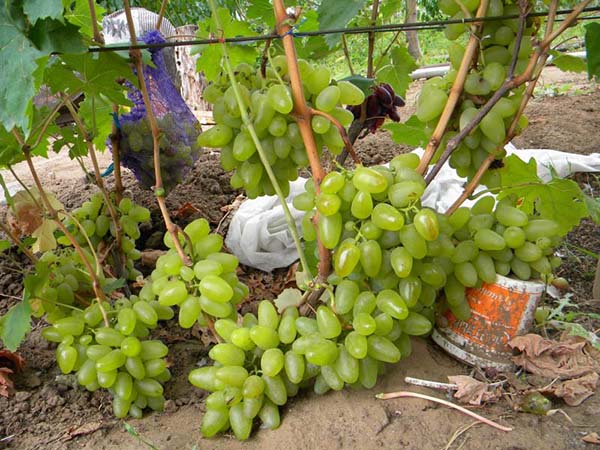
The fruits have a light green-amber uniform hue. The berries are large (42 by 23 mm), but they are nipple and ovoid - 35 by 27 mm, weighing up to 20 grams. Has a harmonious taste with a light fruity aroma (from cherry to apple, depending on sugar accumulation). The pulp is juicy and fleshy, the skin is thin.
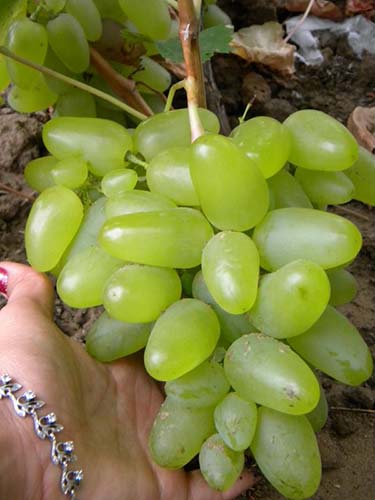
Characteristics of the Bazhena variety:
- ripening period - 105-115 days (very early);
- sugar accumulation (sugar content) - 15-16%;
- acid level (acidity) - 4-6 g / l;
- the load of the eyes on the bush is 25-35;
- it is optimal to make an average cut of 6-8 eyes (but you can also cut it short);
- frost resistance up to -21 ..- 24 degrees.
Advantages:
- High-yielding variety.
- The flowers on the plant are bisexual, which contributes to a stable ovary.
- Ripening of shoots is good.
- The cuttings root perfectly.
- Marketability and transportability are high.
- Relative resistance to mildew and powdery mildew (3-3.5 points).
Disadvantages:
- Sometimes it is affected by wasps.
- The tip of the berry may crack (with frequent rains).
Bulgaria resilient (Queen of Paris)
The hybrid was bred on the basis of the SV20-473 and Bulgaria varieties. Bulgarian selection.
The variety is medium-sized.
Dense clusters in Bulgaria can be either conical or cylindro-conical. The weight of one brush is about 350-500 g (maximum 800-1200 grams).

The fruits are white with a pale pink blush. The berries are round and large in size, weighing 4-7 g.The consistency of the juicy pulp is fleshy, with a delicate skin, which is not noticeable when consumed. The taste of Bulgarian berries is pleasant, there is a strong aroma of nutmeg.
Characteristics of the Bulgaria variety:
- ripening period - 115-125 (early);
- sugar content - 17-20%;
- acidity - 5-6 g / l;
- the number of fruitful shoots is 70-80%;
- fruiting coefficient - 1.7-2.3;
- yield per bush - 10-15 kg (up to 200 centners per hectare);
- the load on the bush during pruning is 40-50 eyes;
- trimming for 6-8 eyes (short is allowed);
- frost resistance up to -20 ..- 21 degrees.
Benefits:
- High tasting level (8.2 points).
- Very productive.
- Marketability is high.
- Excellent ripening of the vine.
- No peas.
- Doesn't burst after rains.
- Relative resistance to fungal diseases (3-3.5 points).
Disadvantages:
- Harvest (load) normalization is required.
- Sufficiently tolerates transportation.
Delight White (Delight)
This variety is obtained by combining the qualities of Zori Severa and Dolores, as well as Russian early. Breeding VNIIViV them. Ya.I. Potapenko (Russia).
Bushes are medium to vigorous.
By the way! It has established itself well as an arched culture, i.e. can be grown on gazebos.
The bunches can be shapeless, or they can take the shape of a cone. Their weight varies within 600-800 g (up to a maximum of 2 kg), depending on the cultivation technique.
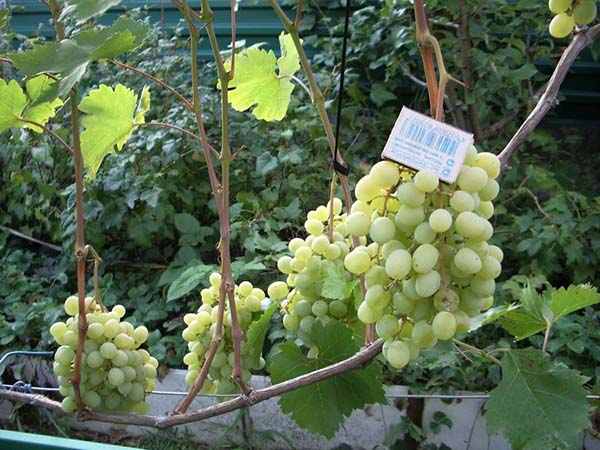
The fruits have a soft creamy shade with a slight blush on the skin on the sunny side. The fruits are large, their weight is 5-8 g. The taste is harmonious. It has a crispy, dense pulp with a thin skin, which is almost imperceptible when consumed (eaten).
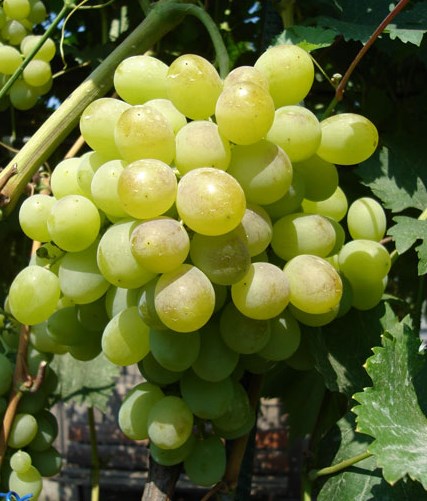
The main characteristics of the White Delight variety:
- ripening period - 110-120 days (very early or early);
- sugar ratio - 19-26%;
- acid content - 5-9 g / l;
- the rate of fruitful shoots is 65-85%;
- the number of clusters per shoot - 1.4-1.7;
- the optimal load of the eyes is 35-45;
- trimming can be 6-10 eyes (but you can trim it by 2-4);
- frost resistance up to -25 degrees.
Advantages:
- The tasting indicator is 8.6 points.
- Differs in bisexual flowers.
- Relative resistance to mildew (3-3.5 points) and high - to gray rot (2 points).
- Very good maturation of the vine.
- It can hang on the vine for a very long time and not deteriorate (up to 1-1.5 months).
- The cuttings take root quickly.
- Wasps are not damaged.
- Does not lose its commercial qualities during transportation.
Minuses:
- May be sick with powdery mildew.
- Susceptible to phylloxera.
- Needs vigorous rootstocks.
Kesha White (Delight Superior)
The variety was bred by crossing the variety Vostorg and Frumoasa Albé. Breeding VNIIViV them. ME AND. Potapenko (Russia).
Bushes are vigorous.
The clusters are cylindrical-conical or conical, often shapeless, of medium density. The average weight is 600-900 g.
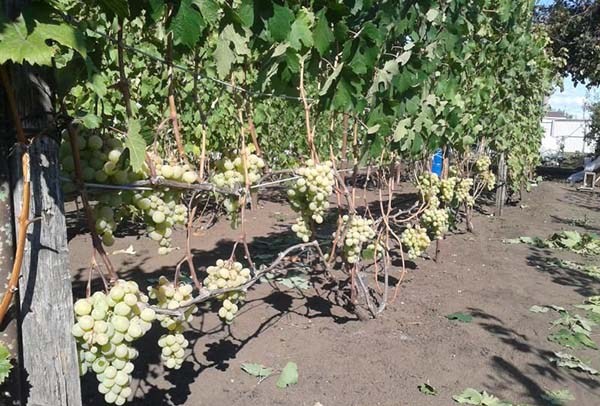
The berries are of a uniform amber-white color. The fruits are very large, oval, length up to 32 mm, width up to 24 mm, weight on average 10-12 g, some up to 20 grams. Kesha is characterized by a dense texture with a pleasant taste. Seeds per fruit - 1-3.
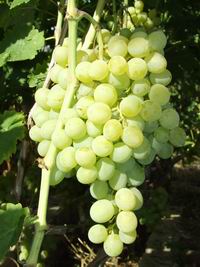
Characteristics of the Kesha variety (Improved Delight):
- ripening period - 120-130 days (early or early middle);
- sugar accumulation - 19-24%;
- the amount of acids is 5-8 g / l;
- the ratio of fruitful shoots is 65-80%;
- the number of bunches - 1.2-1.6;
- eye load - 35-40;
- needs to be trimmed for 8-12 eyes.
Advice! Kesha will bear fruit better on strong formations with a large supply of perennial wood.
- frost resistance up to -23 degrees.
Benefits:
- Tasting qualities (8.0 points).
- Has flowers of both sexes.
- Highly resistant to mildew.
- Shoots ripen well.
- High percentage of rooting cuttings.
- Never peas.
- It can hang without loss of taste until the very frost.
- High transportability.
Disadvantages:
- With a strong load on the brushes, the berries become smaller.
- He does not like frequent temperature changes and icing of the vines, because of this, the buds are vomited.
Important! Do not over-feed with nitrogen fertilizers.
Lily of the valley
Obtained by crossing the varieties Talisman and Kishmish radiant, selection by V.V. Zagorulko (Ukraine).
The variety is very vigorous. The flower is bisexual.
Bunches are cylindro-conical or conical, large, moderately loose, weighing 500-700 g.
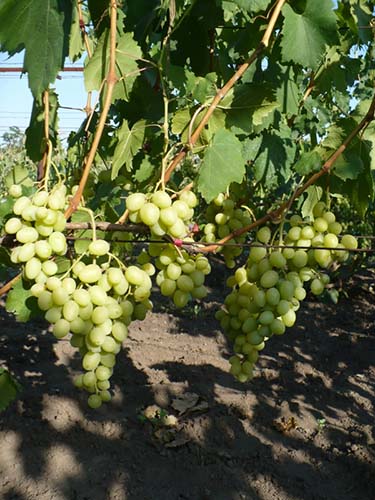
The berries are lemon-yellow, elongated, oval-cylindrical, some with a pointed tip, large and very large (36 by 22 mm), 8-14 g, some up to 16 g. The skin is dense. The pulp is fleshy and juicy, a very sophisticated nutmeg aroma with hints of lily of the valley or acacia flowers.

Characteristics of the Lily of the Valley variety:
- ripening period - 125-135 days (early middle);
- sugar content -18.4 g / 100 cm3;
- acidity - 6.2 g / dm3;
- frost resistance up to -21 degrees.
Advantages:
- It can be stored on a bush for a long time without losing its taste.
- High commercial quality.
- Wasps don't attack.
- Relative resistance to mildew, oidium (3.5 points).
Disadvantages:
- Sometimes the berries burst;
- There are shedding.
Important! Sloughing is a problem for all bushes with high vigor and must be properly cared for. Its causes can be underload, excessive soil moisture, imbalance of nutrients (excess nitrogen), zinc fertilization. It is also important to pinch the growth point (7-10 days before the expected shedding) and remove all stepchildren, except for the topmost one.
Laura (Flora)
The species was obtained by crossing a mixture of pollen from Muscat of Hamburg and Husayne, Muscat de Saint-Velier, Queen of Tairovskaya and a mixture of pollen from Central Asian varieties. Selection IV&V them. V.E. Tairova (Ukraine).
Laura is a medium- or vigorous-growing bush that is weakly pinned, but when pinching, 1-2 leaves must be left, otherwise the buds intended for growth next year will start to grow.
Forms conical clusters of predominantly loose structure weighing up to 1 kg (on average 600-800 grams).
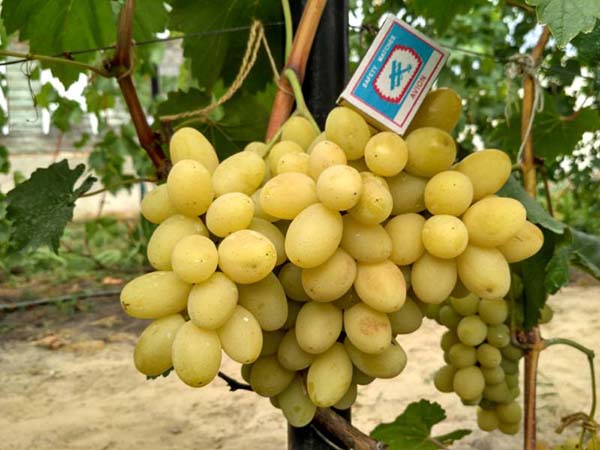
The color is light green with white prune; in the sun the fruits acquire a light tan. The berries are either cylindrical or oval, size - 30 by 22 mm, weight - 6-10 g. The flesh is crispy, the seeds are large. The rind is firm but thin. The fruits are firmly attached to the stalk, so the clusters do not crumble. The taste of the grapes is unobtrusively pleasant (accentedly oriental).
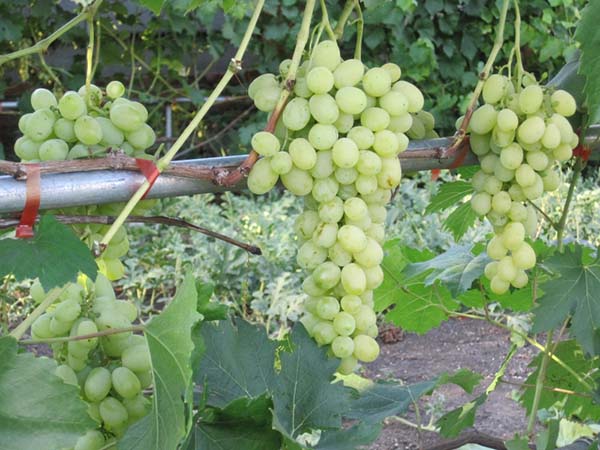
Characteristics of the variety Laura (Flora):
- ripening period - 110-115 days (very early);
- sugar accumulation - about 20% or more (up to 23%);
- acidity - 5-8 g / l;
- the number of fruitful shoots - 60-80%;
- the number of bunches per fruitful shoot - 1.3-1.5;
- eye load - 40-50;
- vines can be cut medium by 5-6 eyes or short by 2-4.
Note! The variety is not picky about care and is flexible to climatic conditions.
Benefits:
- High tasting score (8.9 points).
- Flowers are predominantly female, but pollinated well and the ovary occurs evenly.
- Good vine maturation.
- Cracking of the fruit is extremely rare.
- Relative resistance to mildew (3 points).
- Not affected by gray mold.
- High resistance to phylloxera.
- Not peas.
- Can hang on bushes for a long time and accumulate sugar.
- Not damaged during transportation.
- Excellent marketable berry.
Advice! The use of gibberellin lengthens the berries and produces seedless grapes.
Minuses:
- Sometimes it is affected by powdery mildew.
- Berries, due to the high percentage of sugar, are often damaged by wasps.
By the way! If you use vigorous rootstocks, you can achieve larger berries, but the ripening period will slightly increase and sugar accumulation will decrease.
Monarch (Chrysolite)
The hybrid was obtained by crossing the Talisman and Cardinal varieties with a mixture of pollen. Amateur selection E.G. Pavlovsky.
The bunches are very elegant and quite large - 500-600 g (there are also 1.5 kg).
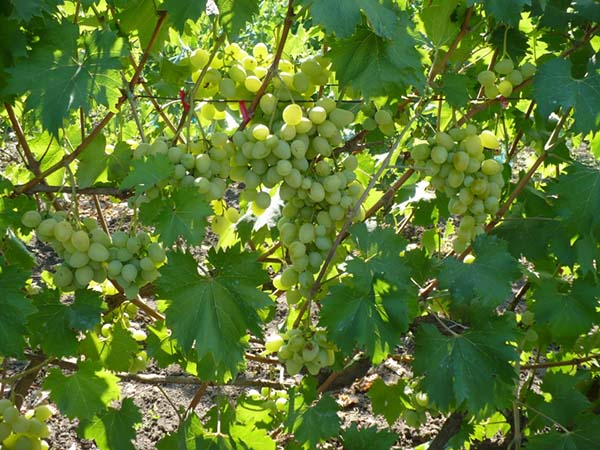
The berries are oval, white-yellow, in the sun with a red tan. Large, 36 by 26 mm in size, weighing 15-20 grams. The pulp is dense, the skin is easily eaten. The taste is harmonious with a delicate nutmeg aroma. 1-2 small seeds per berry.
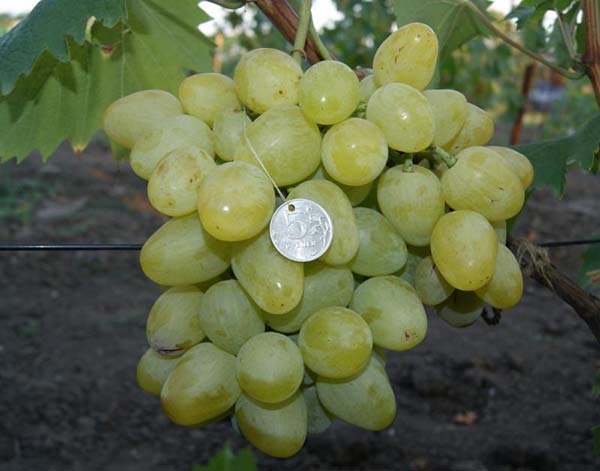
Characteristics of the Monarch variety:
- ripening period - 120-125 days (early).
- frost resistance up to -25 degrees.
Advantages:
- The flower is bisexual.
- No peas.
- The crop is preserved for a long time on the bushes without loss of marketability.
- Shoots ripen well.
- Increased resistance to diseases: mildew, oidium, gray mold (2 points).
Disadvantages:
- Damaged by wasps.
- Poorly pollinated and often the ovary crumbles before flowering.
It is necessary to remove the leaves until the inflorescences fully open so that they do not interfere with pollination in windy weather.
- Careful care and proper cultivation techniques are required.
Important! Chrysolite should not be allowed to "fatten", it should not be normalized before flowering. Also, you should not remove unnecessary and unnecessary shoots until it fades and the berries are pea-sized.
Rusbol (Kishmish Mirage)
Obtained by crossing Villard Blanc and Superearly seedless varieties. Breeding AllRosNIIViV them. Ya.I. Potapenko (Russia) and Bulgaria.
Recommended to grow in plastic greenhouses in all regions.
Own-rooted plantings at first have medium vigor, then strong.
The brushes are large and very large, with an average weight of 400-600 g, maximum 1-1.5 kg, conical, moderately dense or moderately loose.
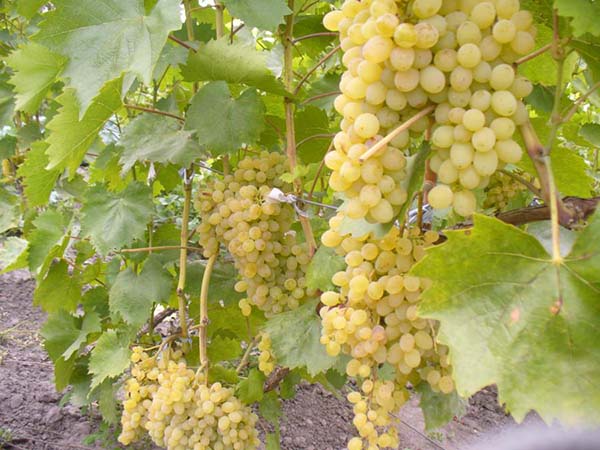
The berries are white-yellow, oval (18 by 16 mm), weighing 5-6 grams, seedless (VI class of seedlessness - there are rudiments). The taste is simple but harmonious.

Characteristics of the Rusbol variety:
- ripening period - 115-125 days (early);
- sugar content - 19-21%;
- acidity - 5-7 g / l;
- fruitful shoots - 85-95%;
- clusters for the escape - 1.5-1.9;
- the load of the bushes is 30-45 eyes;
- trimming for 6-8 eyes is recommended;
- frost resistance up to -25 degrees.
Note! It is often overloaded with harvest due to its high fertility, so it is necessary to promptly remove excess inflorescences and underdeveloped shoots.
Advantages:
- Resistant to mildew, oidium, gray mold.
- The vine ripens well.
- The rooting rate of cuttings is increased.
- Compatibility with most rootstocks is very good, but vigorous shrubs are best.
Disadvantages:
- When overripe, the berries crumble.
- There are quite large rudiments in the berries.
High-punched or medium-length cuffs are recommended.
Super Extra (Citrine)
The grape variety obtained by crossing the Cardinal with a mixture of pollen and Talisman. Amateur selection E.G. Pavlovsky.
Forms vigorous plants.
The size of the clusters is large, and their average weight is 500-800 g (up to 1 kg). The shape can vary from conical to cylindro-conical with or without one wing, and the structure is medium-dense or loose, depending on the conditions during pollination.
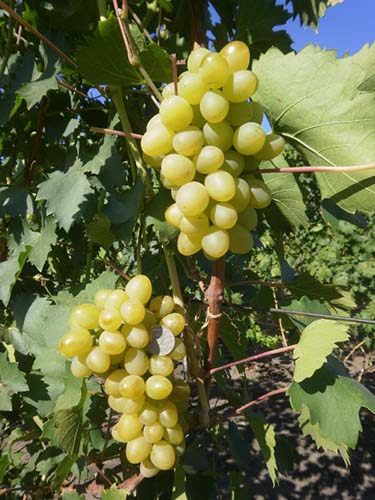
The berries are light green in color with a golden sheen. Super Extra's fruits are round (ovoid), large in size (size 25 by 21 mm) and weighing 7-13 g. Their taste is harmonious (light nutmeg aroma), the pulp is juicy and dense (fleshy), the rind is medium thick.
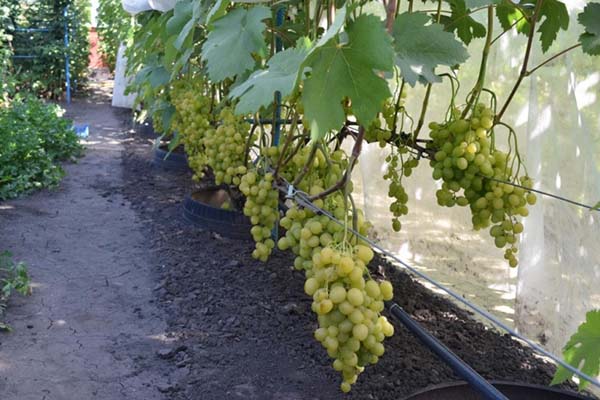
Characteristics of the Super-extra variety:
- ripening period - 100-110 days (very early or very early);
- sugar accumulation - 10%, but sometimes 16-19%;
- acid content - 5-6 g / l;
- frost resistance up to -23 ..- 25 degrees.
Important! Super Extra is prone to peas, so it is recommended to pinch before flowering, and you should not thicken the plantings so that the fruit zone is well ventilated.
Advantages:
- High and stable yield.
- Differs in bisexual type of flowers.
- It remains on the bushes for a long time.
- The vine ripens perfectly.
- Has a decent presentation.
- Not afraid of transportation.
- Resistance to mildew is high, to powdery mildew - medium.
Minuses:
- Prone to peas.
- Unstable against gray mold.
- It is prone to overload, therefore it is necessary to normalize.
- It is unstable to phylloxera.
Talisman (Kesha-1)
The variety is based on the basic qualities of the Rapture and Frumoasa Albé varieties. Selections VNIIViV named after Ya. Potapenko (Russia).
Forms vigorous bushes capable of early fruiting
The bunches are generally of medium density, sometimes they are loose.Their shape resembles a cone, the mass of an average brush is about 800-1200 g.
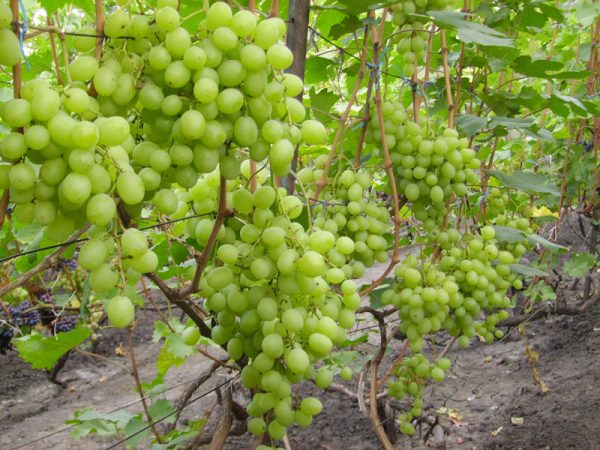
Fruits are white in color; in the sun they acquire a yellow blush. The size of the berries is large, round shape, length - 35 mm, width - 31 mm, weight - 12-16 g. The taste of grapes is harmonious with a nutmeg note (when fully ripe), very sweet and juicy. There are 1-2 seeds in the berry.
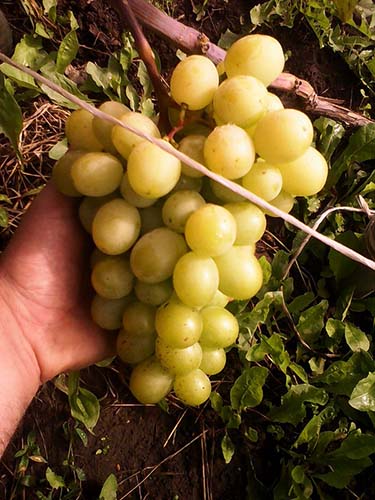
Characteristics of the Talisman variety:
- ripening period - 125-135 days (early middle);
- sugar accumulation - 17-23%;
- acid content - 6-8 g / l;
- fruitful shoots - 75-90%;
- the coefficient of bunches per escape is 1.4-1.8;
- optimal load - 35-45 eyes;
- recommended trimming for 12 eyes;
- frost resistance up to -25 degrees.
Advantages:
- High tasting score (8.5 points).
- High level of sugar accumulation.
- It can hang on the bush for a long time without loss of taste before frost.
- Not damaged in transit.
- Increased resistance to mildew and gray mold.
- Peas are insignificant.
- Not damaged by wasps.
- Female type of flowers, but pollinated well.
- The rooting rate of cuttings is very good, the seedlings are vigorous.
Disadvantages:
- On one shoot, 2-3 inflorescences can form, therefore, it needs to be rationed.
Timur
The hybrid, when crossed, absorbed the best qualities of the Frumoas Albe and Delight varieties. Breeding VNIIViV them. ME AND. Potapenko (Russia).
Forms a weak to medium vigor of plant growth, therefore it is not recommended to plant with vigorous crop species.
Forms cylindro-conical or simply conical clusters weighing 400-600 g, their structure varies from moderately loose to moderately dense.
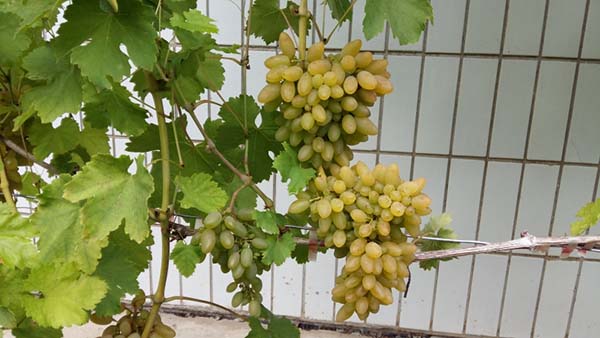
The fruits are white-amber in color with a slight brown tan. Timur's berries are large, 29 by 21 mm in size, resembling an oval in shape with a pointed tip (nipple), weighing 6-9 grams. The pulp is crunchy, with harmonious flavoring properties, in which there is a slight nutmeg hue, but more often the taste is rather tart. The peel of the fruit is thin, torn, not perceptible when consumed.
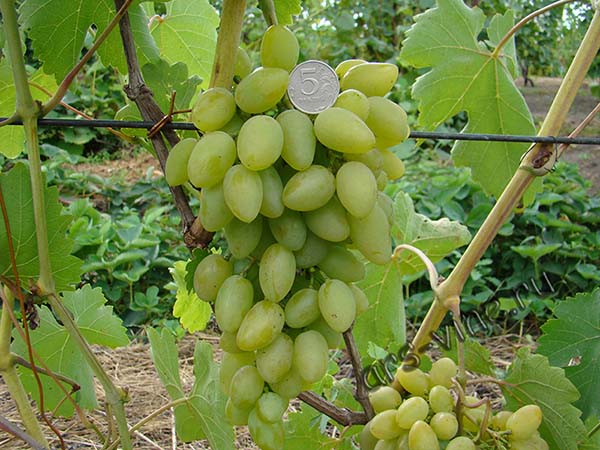
Characteristics of the Timur variety:
- ripening period - 105-115 days (very early);
- sugar content - 17-22%;
- acid content - 6-9 g / l;
- fruitful shoots - 80-90%;
- the ratio of bunches per shoot is 1.5-2;
- optimal load - 30-40 eyes;
- pruning shoots can be used as long - for 8-12 eyes, and short - for 2-4;
- frost resistance up to -25 degrees.
Note! Growing Timur on vigorous rootstocks has a positive effect on the quantity and quality of the crop, but at the same time the ripening of fruits slows down.
Pros:
- Has bisexual flowers.
- Easily propagated by cuttings.
- Begins to bear fruit quickly.
- High index of resistance to mildew and gray mold.
- Good vine maturation.
- It can hang until it gets cold (with almost no sugar loss).
Minuses:
- Peas happen.
- Wasps are often interested.
- Poorly tolerates transportation.
Also quite popular and good varieties of white table grapes are:
- Antoshka;
- Amatea;
- Outrigger;
- Valerie;
- Valentine;
- Viva-Hayka;
- Harold;
- Gold Finger;
- Dovga;
- Olympics;
- Lyra (Miracle);
- Leah;
- Moscow early;
- Crystal muscat;
- Senator;
- Sponsor;
- Shkhelda.
The best white wine (technical) grapes
The following popular white technical grapes are suitable for making wine:
Crystal
The variety was created on the basis of crossing Amur and Challotsi Lajos with Villard Blanc. Hungarian selection.
Variety with medium vigor.
The leaves are dark green in color, strongly cut.
The brushes are medium, of moderate density, their weight varies within 170-220 g.
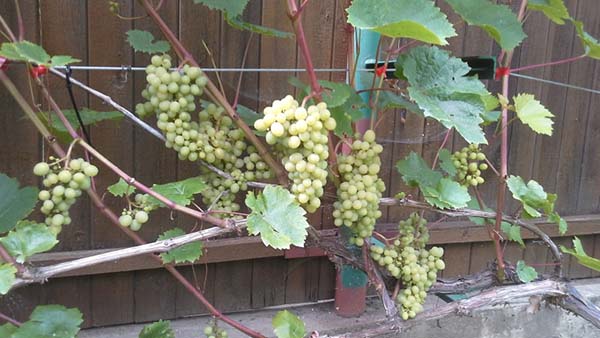
The fruits are yellow-green or white with a prune bloom. Medium size, oval, each weighing from 1.5 to 2.1 g. The pulp is juicy, the peel is strong. The taste is harmonious.
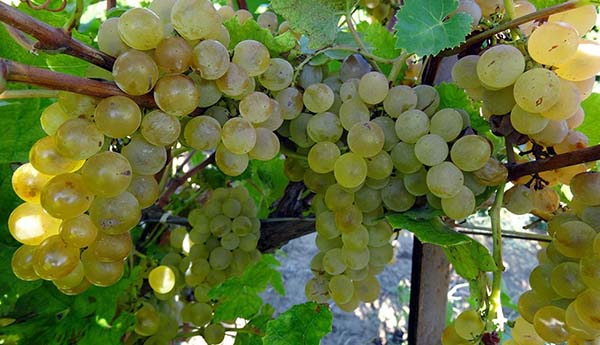
Dry wines of the sherry type are produced from Kristall.
Characteristics of the Crystal variety:
- ripening period - 110-115 days;
- sugar filling - 17-18%;
- acid content - 6-7 g / l;
- the ratio of fruitful shoots - 85-90%;
- the ratio of bunches per shoot is 1.3;
- optimal load - 60 eyes;
- recommended pruning of vines - 3-4 eyes;
- frost resistance up to -29 degrees.
Important! This variety does not tolerate thickening of plantations, which threatens with shedding of the ovary, disheveled brushes and loss of yield.
Benefits:
- Excellent ripening of a one-year vine - 90-100%.
- Ripe brushes remain on the shoots for a long time (until frost).
- Not affected by gray mold.
- High resistance to powdery mildew - 2.5 points, to mildew - 2 points.
Disadvantages:
- With a low level of sugar accumulation, the acidity decreases to 3.5-4 g / l, which significantly reduces the quality of the wine.
Odessa Muscat
The variety was bred by crossing the early blue Muscat and Pierrelle. Selection IV&V them. V.E. Tairova (Ukraine).
Growth strength is above average.
Odessa Muscat is distinguished by tassels of 130-190 g, cylindrical conical shape. Their density is average, often with one wing.
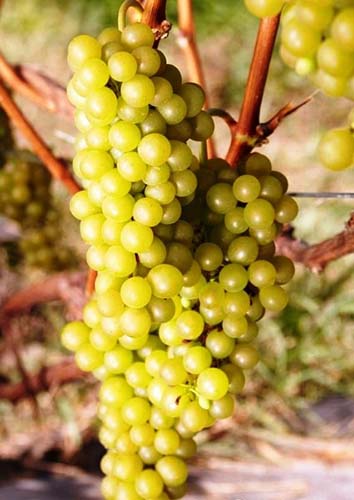
The color of the berry is yellowish green. Fruits are round, measuring 14.2 x 13 mm and weighing about 2 grams. The taste is harmonious with a rich nutmeg aroma. The pulp is slimy, the skin is dense, but thin.
It is used for the preparation of white table and dessert wines, sparkling nutmeg and juices.
Characteristics of the variety Muscat Odessa:
- ripening period - 130-140 days;
- sugar content - 18.6-22%;
- acidity - 5.5-8.7 g / l;
- the ratio of fruitful shoots is 80-87%;
- the number of bunches - 1.2;
- optimal load - 30-35 eyes;
- pruning vines - 3-4 eyes.
- frost resistance up to -24 degrees.
Advantages:
- Highly resistant to mildew (2.5 points) and oidium (2 points).
- Good maturation of shoots.
Platovsky
The variety is obtained by crossing on the basis of the qualities of the Gift of Magarach and Zalandede. Breeding VNIIViV them. ME AND. Potapenko (Russia).
Bushes with medium vigor.
Platovsky is characterized by a cylindro-conical shape of clusters of moderately dense structure, the mass of which reaches 200 g.
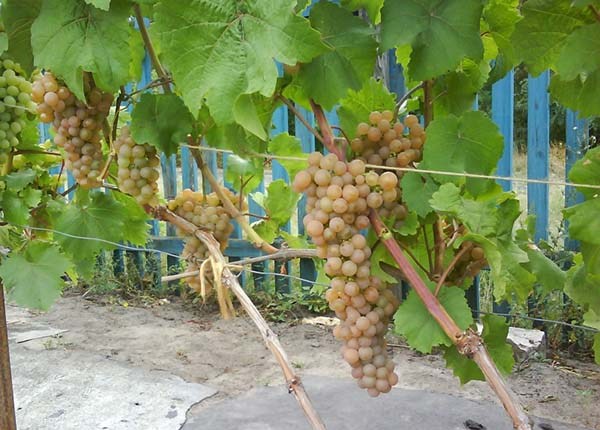
White-pink color. The fruits have a juicy pulp with a thin but dense skin. Weight of 1 berry is 2-3 g. Taste properties of the variety are harmonious.
Characteristics of the Platovsky variety:
- ripening period - 110-115 days;
- sugar accumulation - 20%;
- acidity - 9 g / l;
- fruitful shoots - 85%;
- bunch ratio - 1.3;
- optimal load - 60-80 eyes;
- recommended pruning of vines - 3-4 eyes;
- frost resistance up to -29 degrees.
Important! To speed up the ripening process of fruits, Platovsky needs the timely removal of the foliage covering the bunches.
Advantages:
- High tasting index of dry table wine (8.4 points)
- Good ripening of shoots (about 80%).
- High resistance to mildew (2 points), gray rot (2 points), powdery mildew (2.5 points), average - tophylloxera (3 points).
- The crop lasts 30 days on the bush without losing its qualities.
Disadvantages:
- Mandatory removal of stepchildren, sterile and underdeveloped shoots is required.
- Poorly picks up wood.
- Needs rationing (no more than 2 bunches per shoot).
- Needs a special rootstock - Kober 555.
Also, the following white grapes (in alphabetical order) are suitable for making wine:
- Bukovinka;
- Gewurztraminer;
- Malvasia;
- Muscat;
Odessa Muscat is one of the most popular Muscat for wine. Golodrygi Muscat (a universal variety) is also popular.
- Gift of Magarach;
- Firstborn of Magarach;
- Semillon;
- Solaris;
- Sauvignon Blanc;
- Riesling;
For example, Riesling Maharach.
- Citron Magaracha;
- Chenin Blanc.
Of course, there are other white wine grapes, but they are exclusively regional (such as Aligote, Pinot blanc or Pinot gris). Therefore, getting their cuttings (seedlings) and growing it will be extremely difficult (if not impossible).
Now you know which white grapes to choose for planting in your garden, or buy from the market for fresh berries or white wine.

